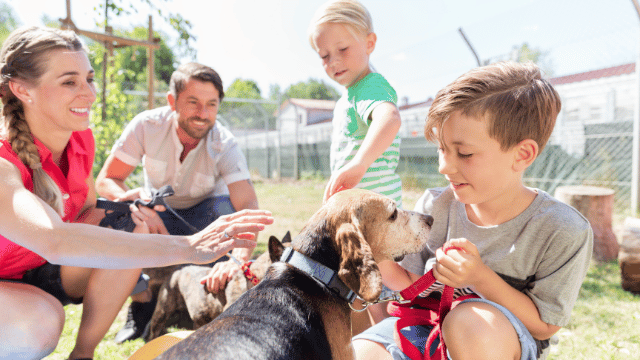If you’ve ever brought a dog into your home, you know the mix of excitement and challenges it can bring. Have you thought about how a rehomed dog feels in this transition? Understanding their emotional journey is crucial. From anxiety and fear to adjustment and behavioral changes, dogs experience a whirlwind of emotions. Discover the emotional challenges faced by rehomed dogs and find practical strategies to help them feel secure in their new environment.
Rehomed Dogs’ Emotional Challenges
When a dog is rehomed, they may experience a range of emotional challenges as they adjust to their new environment. Emotional stress can manifest in various ways, such as anxiety, fear, sadness, or confusion. Adjustment struggles are common as dogs navigate unfamiliar surroundings, people, routines, and sounds. Trust building becomes essential during this period to help the dog feel secure and comfortable in their new home. Behavioral changes like reluctance, avoidance, or changes in eating and toilet habits may indicate the stress a rehomed dog is facing. Providing a supportive environment is crucial for addressing these emotional challenges. Offering patience, love, consistent routines, and positive reinforcement can assist in helping the dog overcome their emotional hurdles. By creating a safe and loving space, you can support your rehomed dog through this transition and help them thrive in their new environment.
Behavioral Responses and Support
To support a rehomed dog’s behavioral responses, focus on understanding and addressing their emotional challenges through patience, love, and consistent routines. Training techniques play a crucial role in helping your dog adapt to their new environment. Utilize positive reinforcement methods to encourage desired behaviors and build trust. Behavioral therapy can be beneficial for addressing any underlying issues such as fear or aggression. Socialization tips are essential for helping your dog feel comfortable around new people, animals, and environments. Introduce them gradually to different situations to prevent overwhelming them.
Providing mental stimulation through interactive toys, puzzles, and activities can help keep your dog engaged and prevent boredom or anxiety. Emotional bonding is key to forming a strong connection with your rehomed dog. Spend quality time together, show affection, and be a source of comfort and security. Remember, each dog is unique, so tailor your approach to suit their individual needs. With patience and understanding, you can help your rehomed dog adjust and thrive in their new home.
Factors Affecting Emotional State
Factors impacting a rehomed dog’s emotional state include previous experiences, shelter environments, and the establishment of trust and routines. To help you understand these factors better, let’s delve into some key strategies and processes that influence a dog’s emotional well-being.
| Trust Building Techniques | Bonding Strategies |
|---|---|
| – Spend quality time together | – Engage in interactive play |
| – Use positive reinforcement | – Establish eye contact |
| – Respect your dog’s boundaries | – Incorporate training sessions |
Emotional stability in rehomed dogs is crucial for a smooth adjustment process. Implementing behavioral rehabilitation techniques can aid in building a strong foundation for your new furry companion. By focusing on trust-building, bonding, and providing a consistent routine, you can help your dog feel secure and loved in their new environment. Remember, patience and understanding play key roles in supporting your rehomed dog’s emotional journey.
Strategies for Safety and Security
Implement trust-building techniques and bonding strategies to ensure the safety and security of your rehomed dog in their new environment.
- Building Trust
- Engage in positive interactions and offer treats to create a bond based on trust.
- Spend quality time together to establish a connection and reassure your dog.
- Safe Retreat in Designated Room
- Provide a quiet space with their essentials where they can feel secure.
- Allow them to retreat to this area whenever they need comfort or solitude.
- Consistent Routines and Positive Reinforcement
- Stick to regular feeding times, walks, and play sessions to create stability.
- Use positive reinforcement techniques to encourage good behavior and build confidence.
Practical Tips for Support
For practical support in helping your rehomed dog adjust smoothly, maintain stability and consistency in their daily routines. Building trust through positive reinforcement is essential for your dog’s emotional health. Consistent routines, such as regular mealtimes, walks, and playtime, will provide a sense of security. Introduce your dog to socialization opportunities with family members and other pets gradually to create a safe environment for interaction. Monitor your dog’s behavior closely for any signs of distress, and don’t hesitate to seek help from professionals if needed. Creating clear boundaries and showing affection will help your dog feel loved and secure in their new home. Remember, your presence and patience are vital in supporting your rehomed dog through this transition period.
| Support Tips | Key Actions |
|---|---|
| Building Trust | Use positive reinforcement to establish trust. |
| Consistent Routine | Maintain regular schedules for meals, walks, and playtime. |
| Socialization | Introduce your dog to new environments and other pets gradually. |
| Monitoring Behavior | Watch for signs of distress and seek professional help if needed. |


